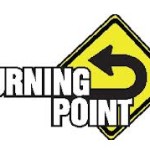Plot points, turning points, complications—these terms describe writers’ tasks for upping tension, squeezing the character and keeping readers turning pages.
Writing Tip for Today: Let’s look at some basics of writing turning points in fiction or memoir.
Point: Everything Changes
In every story, an event or scene must show the reader a place in which the character’s world is forever changed. Usually, this place occurs near the beginning of a story. Set-up the character’s “normal” world in as brief a way as possible (who this is, where it’s set and the approximate time, such as present day), something happens. Think of it as a Turning Point where things will never be the same again.
This something either brings a previously held goal to the forefront, or the character is forced to desire a goal to correct circumstances. The Inciting Incident, as it’s often called, starts the character on the story’s timeline to secure the goal. Remember, this goal must be desperately desired and it must attract worthy obstacles to keep the character from fulfilling the goal.
The Inciting Incident propels the character toward the goal. Some characters start out confident, while others are just as certain they’ll never reach the goal. Yet the Inciting Incident must be important enough for the character to pursue the goal even if he/she is reluctant. The So What? Test can help you determine if the goal is worthy. Ask yourself what happens if the character doesn’t reach this goal. The answer should NOT elicit “So what?”
Point: Things Get Worse (and Worse)
After the Inciting Incident, the character usually has some mistaken idea of how easy or difficult the quest will be. That’s the perfect place for a Turning Point, where things suddenly get worse for the character. Often called a complication, this bump in the road derails the character’s earlier perception of the ease or difficulty of the goal.
Enter your Obstacles. Obstacles can be anything (or anyone) standing in the way of your character’s goal. Again, make sure they’re worthy, that your character will have to work to overcome it. Don’t make things too easy—when your character overcomes all obstacles, the story is over. Obstacles could be human (Antagonist), Self, the landscape or even animals. Be sure to hold back the worst possible battle for later in the story.
As your character moves one step forward and three back, more complications should arise, each more daunting than the last. Don’t allow the pressure to let up on your character for long. And as you approach the end of Act II, you’ll need an “All is Lost” moment before the final climax scene.

You’ll need an “All is Lost” moment before the climax scene.
Point: The Last Battle
Some writers want to think that there can be more than one climax. Nope. Think about what the climax means—it’s the acme of the story in terms of tension, conflict and either winning the goal or not. Save your Obstacles’ greatest roadblock for this scene. Your character must summon the last ounce of courage to face this last biggest obstacle and either succeed or fail.
In earlier complications, you can withhold information so that along with the character, the true threat of the obstacle becomes apparent only at the climax. This climax makes the biggest statement if you write this scene with the characters’ emotions showcased. The protagonist understands his goal in ways he didn’t before. The Antagonist bares his true motive for hindering the goal. Emotions will help you highlight these revelations.
The last Turning Point reveals the outcome or resolution of the story. Only a few outcomes are possible, and they are all tied to emotion: the character succeeds and is happy/not happy; the character fails and is happy (didn’t really want it after all) or not happy. Apathy or ambivalence is usually not recommended. Test your story to map out your Turning Points and your readers will thank you.





